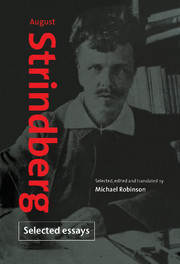Book contents
- Frontmatter
- Contents
- Notes on the text
- Introduction
- from Vivisections (1887)
- ‘On Modern Drama and Modern Theatre’ (1889)
- from Vivisections II (1894)
- ‘Césarine’ (1894)
- ‘Deranged Sensations’ (1894)
- ‘In the Cemetery’ (1896)
- from Jardin des Plantes (1896)
- ‘On the Action of Light in Photography’ (1896)
- ‘A Glance into Space’ (1896)
- ‘Edvard Munch's Exhibition’ (1896)
- ‘The Synthesis of Gold’ (1896)
- ‘Contemporary Gold-Making’ (1896)
- ‘The Sunflower’ (1896)
- ‘The Mysticism of World History’ (1903)
- ‘August Strindberg on Himself’ (1909)
- Notes and commentary
- Index
‘Contemporary Gold-Making’ (1896)
Published online by Cambridge University Press: 18 December 2009
- Frontmatter
- Contents
- Notes on the text
- Introduction
- from Vivisections (1887)
- ‘On Modern Drama and Modern Theatre’ (1889)
- from Vivisections II (1894)
- ‘Césarine’ (1894)
- ‘Deranged Sensations’ (1894)
- ‘In the Cemetery’ (1896)
- from Jardin des Plantes (1896)
- ‘On the Action of Light in Photography’ (1896)
- ‘A Glance into Space’ (1896)
- ‘Edvard Munch's Exhibition’ (1896)
- ‘The Synthesis of Gold’ (1896)
- ‘Contemporary Gold-Making’ (1896)
- ‘The Sunflower’ (1896)
- ‘The Mysticism of World History’ (1903)
- ‘August Strindberg on Himself’ (1909)
- Notes and commentary
- Index
Summary
To the Chemical Society in Stockholm
The moment William Crookes declared that there were no elements the further question immediately arose, what do they consist of, or how are they constituted; and with that, a new project in chemistry begins. Some twenty years ago, at the Académie des Sciences in Paris, Lockyer presented a paper on the composition of phosphorus in which his spectral analytic investigations convinced him that phosphorus was not an element. Krüss or Krauss (I am quoting from memory) had transmuted cobalt salt into nickel salt; at the Institute of Physics in Berlin Gross had declared that sulphur was not an element, since in the electrolysis of sulphate of barium he had regularly lost a certain amount of sulphur.
In the meantime, Berthelot, who had studied the alchemists, had declared publicly that he did not believe in elements, and that a solution to the problem of how to make gold was only a question of time.
Like all opinions, this was not a new one. Through the discovery of molecular substitution Dumas had been able to conclude that the chemical compounds, such as they are listed in the textbooks, were only arbitrarily chosen, an idea formulated in his well-known expression: ‘There are 400,000 kinds of ammonia.’
Proust attempted to found a system based on the unity of matter which established that the elements were only condensations of hydrogen, upon which Blomstrand8 built further in the essay ‘The Elements of Nature’, even though he shrank from the consequences.
- Type
- Chapter
- Information
- August Strindberg: Selected Essays , pp. 173 - 177Publisher: Cambridge University PressPrint publication year: 1996



